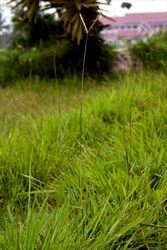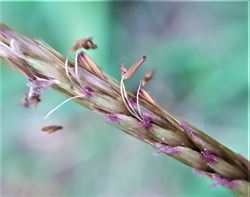Polytrias indica. Previously, it was known as Ischaemum indicum, among many other synonyms. It is a member of the Poaceae. Note, Flora of China states: "This grass has been widely known as Ischaemum indicum (Houttuyn) Merrill (Phleum indicum Houttuyn), but that name in fact refers to a species of Polytrias". Kew (Plants of the World Online) accepts Polytrias indica as the correct name with Ischaemum indicum as a synonym. However, the identity of the plants in Pacific island countries is not clear. Australia is a likely source of the grass for those countries where Ischaemum indicum is presumed to be present but, in Australia, collections have been identified as Ischaemum indicum and also Ischaemum tropicum. Under the circumstances, it is best if specimens are collected from Pacific island countries and re-dentified by a grass taxonomist.
The images are all from WIKTROP as Ischaemum ciliare Retz.The website lists several Ischaemum indicum varieties as synonyms. The Royal Botanic Gardens Kew, Plants of the World Online also list Ischeamum indicum as a synonym of Polytrias indica (Houtt.) Veldkamp.(https://powo.science.kew.org/taxon/urn:lsid:ipni.org:names:963150-1). POWO (2022). Plants of the World Online. Facilitated by the Royal Botanic Gardens, Kew. (http://www.plantsoftheworldonline.org/).








